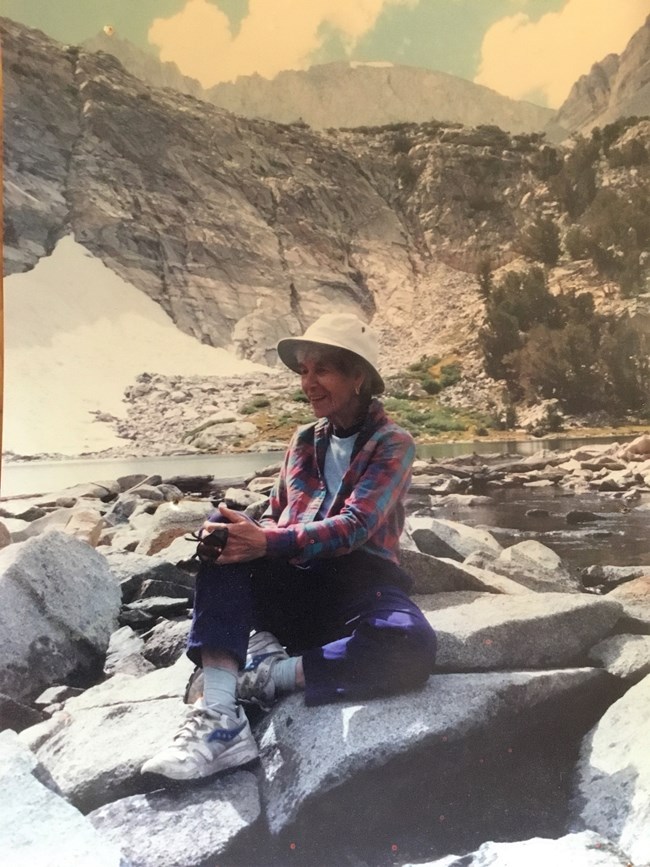Part of a series of articles titled Women's History in the Pacific West - California-Great Basin Collection.
Next: Lilian Snooks
Article

Photo credit: Sydney Quinn
Article Written By Emma Chapman
Genny Smith worked tirelessly to protect the High Sierra Nevada’s natural beauty. She was a pioneering environmental activist and author who raised public awareness and organized multiple campaigns toward that end.
She was born Genevieve Hall in San Francisco in 1922. She earned a degree in political science at Reed College in Portland, Oregon. During the 1940s, she worked as a summer camp director, a recreation manager for the Red Cross in Utah, and a community center employee in Hawai‘i. She married twice, first to paleontologist Gerhard Schumacher in the late 1940s, and, after her divorce, to Stanford geologist Ward C. Smith in 1968.1 Her introduction to the beauty of Mammoth Lake and the Eastern Sierras came through a ski club she joined while working as a teacher in Bakersfield, California in the 1950s. Inspired by her experiences on the slopes, she became an avid backpacker of the High Sierra Nevada and purchased a cabin in the Twin Falls Tract.2
She also pursued her commitment to the region as a writer. In 1959, she wrote one of the first guidebooks to the Eastern Sierra, Mammoth Lakes Sierra, followed a few years later by her guidebook to the Owens Valley, Deepest Valley. In these guidebooks, Smith described the major sights as well as the flowers, fish, and mammals that populated the Eastern Sierra and made them unique. Her success as a writer led her to a publishing career. She opened Genny Smith Press, dedicated to publishing stories about nature, activism, and local history.3
Smith was an effective environmental activist who was particularly skilled at elevating local voices. In 1958, she began what turned into a twenty-seven-year-campaign against a proposed highway that would have cut through the pristine Eastern Sierra. Smith peopled that campaign with a coalition of environmentalists, vacationers, locals, and naturalists. She led letter-writing campaigns and arranged for the publication of numerous editorials in major California newspapers. Finally, in 1972 Smith achieved victory when California Governor Ronald Reagan announced the road project’s cancellation.4
Building on that success, Smith continued to organize to preserve natural spaces around Devils Postpile, skillfully working within the possibilities created by the 1964 Wilderness Act. She was one of the organizers of the San Joaquin Wilderness Association in 1978, which opposed ski area expansion and other potential development in Middle Fork Valley.5 Her efforts also extended into other parts of the Eastern Sierra; in the 1980s, she successfully worked with a small-town organization to sue the Los Angeles Department of Water and Power for piping large amounts of water out of Mono Lake. With her help, the Mono Lake Committee won a massive environmental victory in the courts that limited the amount of water Los Angeles could take from the lake.6
Into the twenty-first century, she continued her varied work and mentored younger activists. She continued to ski and hike in the High Sierra well into her nineties. In 2017, the Mono Lake Committee recognized her preservation work with the Andrea Lawrence Award, named for a local Olympic skier and awarded to locals who have done exceptional community and environmental work. When Smith died in 2018, she left a legacy of committed activism and mentorship that continues to inspire environmentalists drawn to the mountain terrain that she worked so hard to protect.7
1 - 1 1930 Census San Francisco, San Francisco, California; Page: 13A; Enumeration District: 0146; FHL microfilm: 2339935 , Ancestry.com. 1930 United States Federal Census [database on-line]. Provo, UT, USA: Ancestry.com Operations Inc, 2002; “Genevieve Hall Smith '43,” Reed Magazine | In Memoriam (Reed College, June 2018), https://www.reed.edu/reed-magazine/in-memoriam/obituaries/2018/genevieve-hall-smith-1943.html; “Genny Smith, 1922-2018,” The Sheet , Obituary, March 10, 2018, https://thesheetnews.com/2018/03/09/genny-smith-1922-2018/; Bakersfield City Directory, 465, Ancestry.com. U.S. City Directories, 1822-1995 [database on-line]. Provo, UT, USA: Ancestry.com Operations, Inc., 2011;
2 - Abagael Giles, “Love the Wild Sierra? Thank Genny Smith,” The Sheet, September 30, 2016, https://thesheetnews.com/2016/09/30/love-the-wild-sierra-thank-genny-smith/;
3 - Giles, “Love the Wild Sierra? Thank Genny Smith”; “Genevieve Hall Smith '43”; “Genny Smith, 1922-2018.”
4 - Christopher E. Johnson, Nature and History on the Sierra Crest: Devils Postpile and the Mammoth Lakes Sierra (Seattle: National Parks Service, Pacific West Regional Office, 2013), 137, 140. See also “Genevieve Hall Smith '43,” and “Genny Smith, 1922-2018.”
5 - Johnson, Nature and History on the Sierra Crest, 169-71.
6 - “Genevieve Hall Smith '43”; “Genny Smith, 1922-2018.”
7 - George I. Smith, “Memorial to Ward C. Smith, 1906-1998,” The Geological Society of America, August 1998, https://www.geosociety.org/documents/gsa/memorials/v30/smithWC.pdf; Giles, “Love the Wild Sierra? Thank Genny Smith”; “Genevieve Hall Smith '43”; “Genny Smith, 1922-2018.”
Part of a series of articles titled Women's History in the Pacific West - California-Great Basin Collection.
Next: Lilian Snooks
Last updated: February 22, 2022